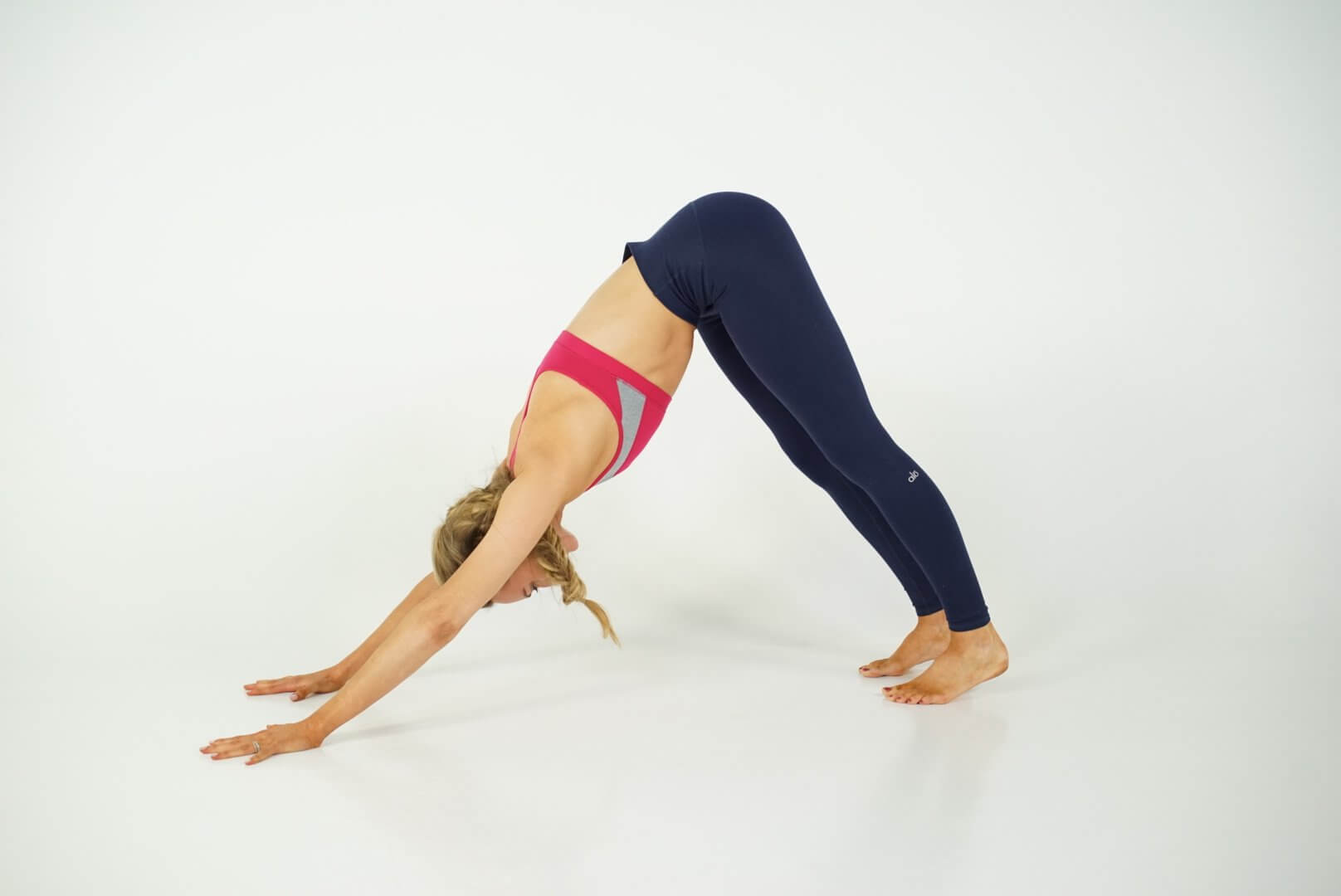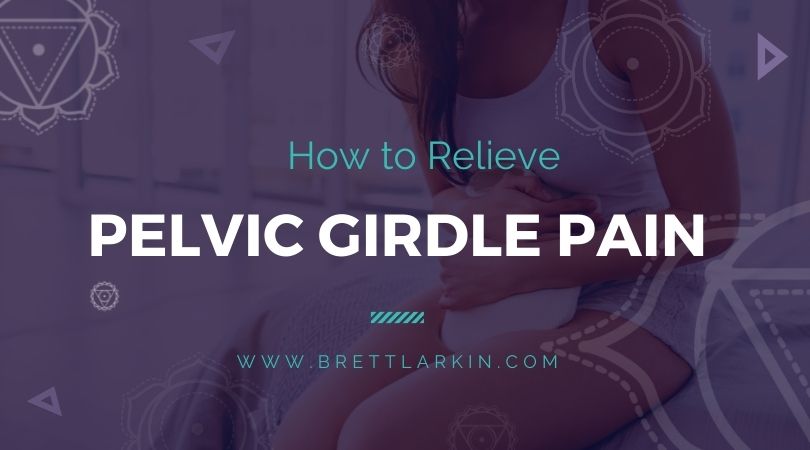
Pregnant women experience all sorts of changes to their body. Many of them encounter pain in areas that they never had problems with before pregnancy. One of those tricky spots is in the pelvis.
If you feel pain in your pelvis during pregnancy or after giving birth, you most likely have pelvic girdle pain (PGP). Don’t worry, this isn’t an end destination. Keep reading to find out what pelvic girdle pain is and what you can do to ease your symptoms.
What Is Pelvic Girdle Pain?
Pelvic girdle pain (PGP) is an overall term for any pelvic pain. You may have heard of symphysis pubis dysfunction (SPD), which causes a stabbing pain in the pubic symphysis – a joint that sits between your pubic bones right above your vulva. You might also be familiar with the term sacroiliac joint (SI) dysfunction, which is linked to aching in the back of the pelvis where your sacrum connects to the large iliac bones.
All of these are now referred to as pelvic girdle pain (PGP) which describes any such pain in the pelvic area. This could be anywhere from the lower back down to the thigh. Most women feel pain in their pelvic girdle during pregnancy or soon after labor.
What Does Pelvic Girdle Pain Feel Like?
Pelvic pain in pregnancy can show up in many different ways from a mild aching to a stabbing, severe pain. Common areas where many women experience pelvic girdle pain include: lower back, pelvic floor, buttocks, outside of the hip, along the inner thigh, and around the pelvic joints (especially, sacroiliac joints and pubic symphysis).
Most women feel this pelvic pain during everyday activities when putting weight on one leg, e.g. getting out of bed, climbing stairs, or getting dressed. Symptoms can also show up when both legs are being used such as standing for long periods and carrying things (especially, heavy weights).
For some women, pregnancy related pelvic girdle pain can be constant and pain intensity can increase while the baby is growing. For others, pelvic girdle pain comes and goes.
Pelvic Girdle Pain in Pregnancy
While PGP can cause discomfort throughout pregnancy and during and/or after giving birth, it won’t do any harm to your baby.
Stiffness and the pelvic joints moving unevenly are usually the cause for pelvic girdle pain. When pregnant, a woman’s body releases relaxin which is one of the pregnancy hormones that allows the baby to grow by loosening the ligaments as well as joints. This process can lead to an imbalance in the muscles which the body tries to make up for by holding the pelvis together. As a result women suffer from pelvic pain.
A woman might also experience PGP due to prior injuries or already existing imbalances, especially, in the lower back and pelvic area. This could impact the body’s ability to move and adapt during pregnancy.
How Likely Are You to Get Pelvic Girdle Pain During Pregnancy?
Not every woman experiences pelvic pain in pregnancy. And while it’s hard to predict whether or not you’re going to experience it, these are some risk factors that might contribute to developing PGP:
- previous births and any complications you might have had
- an increased BMI
- any pre-existing injuries or aching in the lower back, pelvis, hips, and upper legs
- previous symphysis pubis or injury to the pubic bone area
- loose joints, also known as joint hypermobility
If you are concerned about developing pelvic girdle pain during pregnancy, it’s best to talk to your team of health professionals.
How to Cope with Pelvic Girdle Pain
An early diagnosis can make a huge difference to help with pain relief in your daily life throughout pregnancy. If you experience pain in your pelvis, it’s best to talk to a healthcare provider (usually a physiotherapist or chiropractor) who specializes in treating pregnant women.
They will do a thorough assessment to provide you with a treatment plan to not only ease pain but also avoid any long term discomfort.
As part of your treatment you might try the following:
- Gynaecological physiotherapy. This could involve manual therapy to support healthy movement of the pelvic joints. You might also be given a pelvic support belt to ease pain or some exercises to strengthen your pelvic floor muscles.
- Relaxation techniques. Massage and soft tissue work are a great treatment option to release tight muscles and pain throughout pregnancy. Yoga and mediation are also great tools to help with pelvic girdle pain. In my online course Pregnant & Powerful you can find an extensive library of content for prenatal yoga and meditation.
- Movement modifications & exercises. Ask your practitioner to help you with finding a comfortable position for everyday activities, e.g. when you sleep or carry things. This mainly involves finding more supportive movement patterns and positions that avoid bearing weight on one leg or directly on your lower back.
You might also find some more tips for your pregnancy journey in my collection of articles for pregnant women.
The Best Yoga Poses to Help Relieve Pelvic Girdle Pain
Prenatal Yoga is a great way to help with pregnancy related pelvic girdle pain. Some poses work better than others – you mainly want to avoid those that make any symptoms or pain worse.
Some of the top Yoga poses to ease pelvic girdle pain and any related symptoms are:
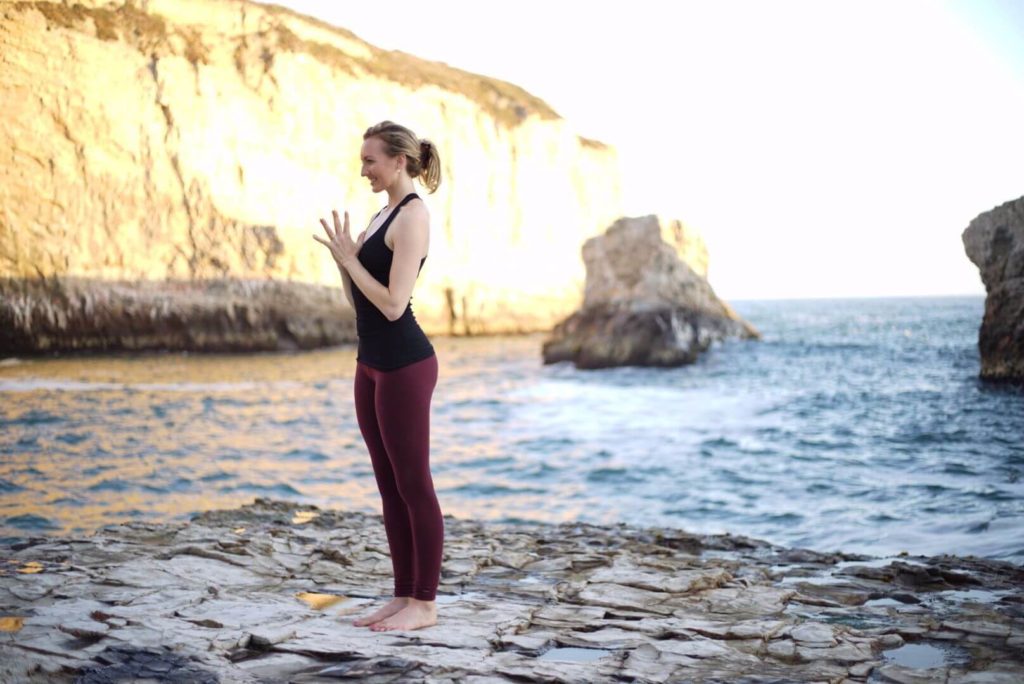
Mountain pose (Tadasana)
Steps:
- Bring your feet into a comfortable distance allowing for equal weight distribution between your legs.
- While pressing down through all four corners of your feet lengthen your spine upwards. Relax your shoulders and slightly drop your tailbone.
- Let your arms rest by your side or bring your hands into prayer.
- Feel your breath in the front, side, and back of your lungs while engaging your inner thighs and abdominal muscles to keep you stable.
Variations: If you struggle with balance, you can practice this pose sitting upright on a chair instead with both of your feet touching the floor. You could also stand against a wall for additional support.
Benefits: Keeps pelvis neutral and allows for equal weight distribution between both legs.
Cow pose (Bitilasana) and Cat pose (Marjaiasana)
Steps:
- For cow pose start in All Fours. Then inhale and draw your heart forward expanding across your upper chest.
- Try not to let your belly sink, but keep drawing the baby up and in so that you are not collapsing through your lower back.
- With your exhale move into cat pose. Press your shoulder blades apart and round your back.
- Allow your head to drop and your gaze to turn towards your belly. If it feels good in your body, try squeezing your pelvic floor muscles to stretch the lower back.
- Repeat as often as you like while connecting your breath to the movement.
Variations: If this causes pain in your wrists, try coming on to your forearms instead. You can also do a seated cow and cat movement, which can allow for more support for your pelvis if needed.
Benefits: Great mobilization for the entire spine, which can help release low back pain as well as pelvic tightness. You will also feel a gentle stretch in your lower back, which may help release pain.
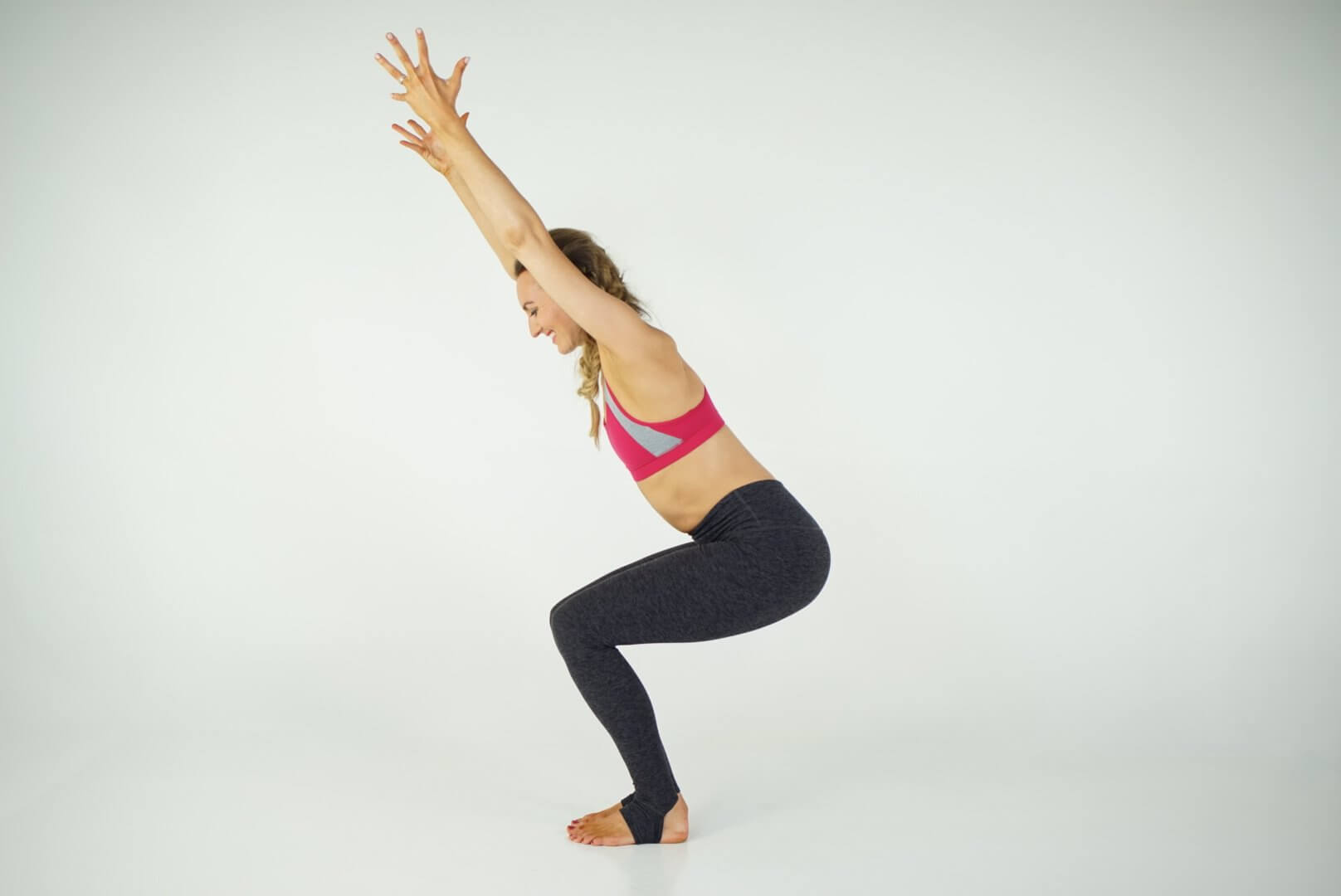
Chair pose (Utkatasana) with a block and/or wall
Steps:
- Start in Mountain Pose. Bend your knees and sit your hips back and down.
- Allow your tailbone to drop and your belly to draw in. Keep your hands on your hips to notice any imbalances between both sides.
- Draw your outer thighs towards your midline to engage the glutes and strengthen the pelvic floor.
Variations: Sit against a wall for additional support. This can also allow you to better find a healthy spine alignment while releasing the lower back. Hugging a block or thick cushion between your thighs can help activate the glutes and open up the lower back while building strength in your pelvis.
Benefits: Strengthens lower body, including transverse abdominis.
Bird Dog Pose (Parsva Balasana)
Steps:
- Start in All Fours with knees under hips and hands under shoulders.
- Try not to sink the belly down and consciously press the floor away from you.
- Extend one leg, then add the opposite arm if it feels good.
- Keep your balance while practicing a smooth, steady breath. Change sides.
Variations: If your wrists are hurting, try lowering down on to your forearms and simply practice extending one leg at a time. You could also use a blanket or roll up your mat to provide a bit of cushioning for your wrists.
Benefits: Strengthens lower back and stabilizes the core, which brings support to the pelvic.
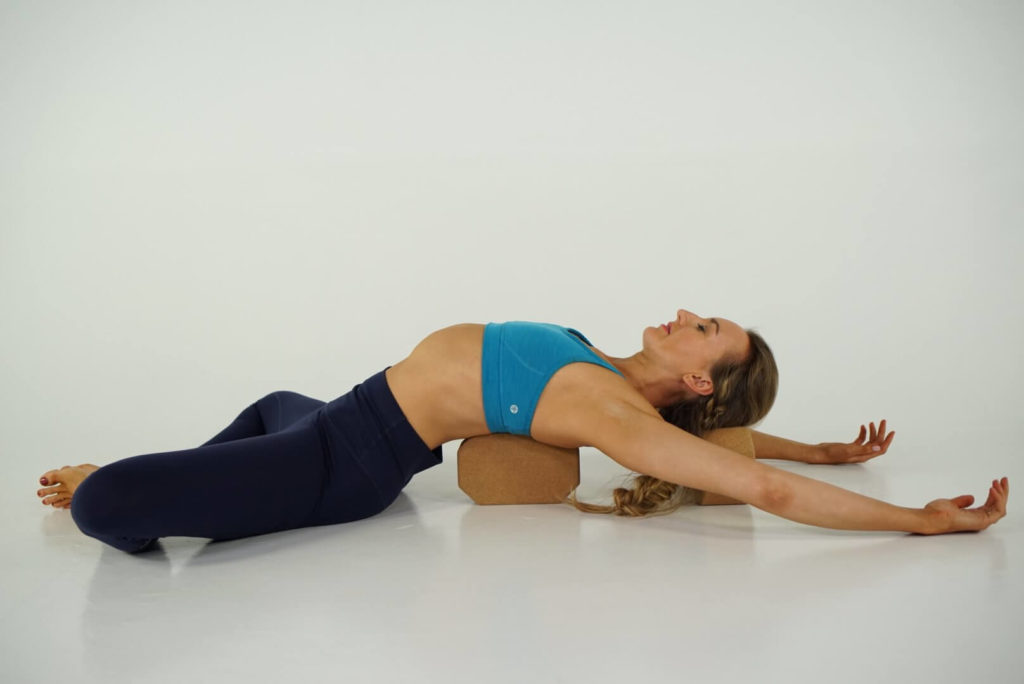
Reclined Bound Angle Pose (Supta Baddha Konasana)
Steps
- Start by lying down on your mat. Bend your knees and bring the soles of your feet together.
- Allow your knees to open like a book and fall toward the ground as much as your body allows.
- Breathe deeply into your belly as you allow your body to lean into the ground. Stay for a few rounds of deep breaths. Reset and repeat as needed.
Variations: If this feels tight in your hip flexors, use some cushions, bolsters or blocks to put either side of your legs. In case your lower back is very tight and aching, use a blanket to slide underneath your hips so that your lower spine has some additional support.
Benefits: Brings a gentle stretch to the pelvic region, inner thighs, and your knees. This also means it stimulates blood flow in these areas relieving any tension and pain.
Downward Dog with a Partner (Adho mukha svanasana)
Steps:
- Ask your birth partner or anyone else close to you to help with this pose.
- Stand in Mountain Pose facing your partner. Hold each others’ hands and then walk your feet back and drop your chest until your arms are extended and your hips are pressed back.
- Keep drawing the baby in and pressing your feet down to activate the back of your legs.
Variations: Do the same against a wall if doing this on your own. Bring your feet wider and bend your knees as much as you need to if your hamstrings feel tight.
Benefits: This will stretch your legs and whole back body. It can also help you find neutral hip alignment.
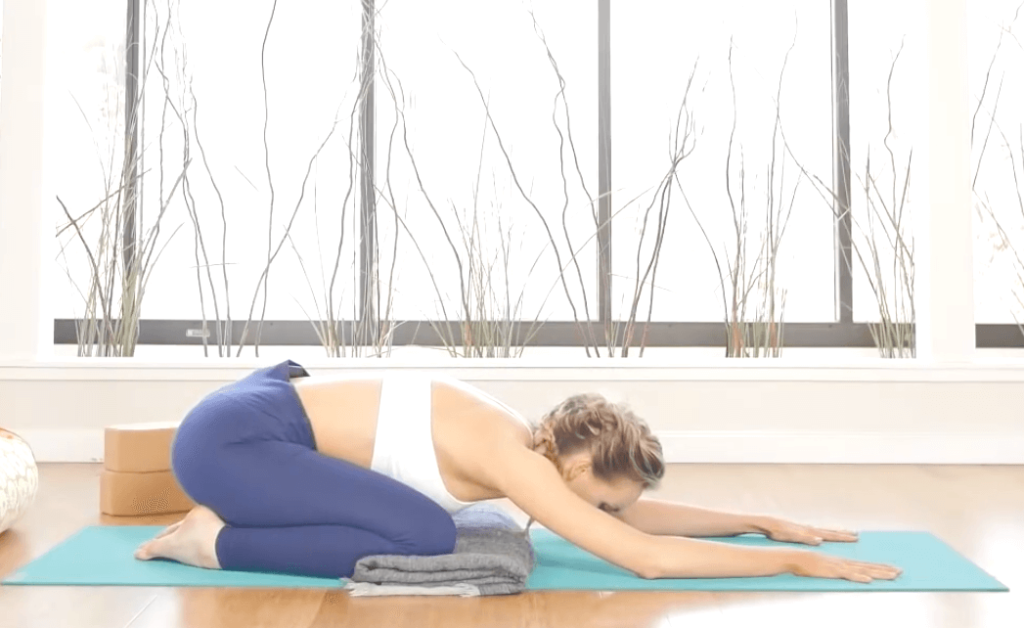
Child’s Pose (Balasana)
Steps:
- Start in All Fours. Take your knees wide enough to give space to your belly while you press your hips into the back of your heels.
- You can rest your arms alongside your body or extend them in front of you. You could also fold your forearms on top of one another to provide extra cushioning to your head.
- Allow your upper body to relax into your thighs. Breathe into your back body and with each exhale try to soften a little bit more.
Variations: Use a bolster or blankets as support underneath your belly if your hips are tight. You can also place a blanket or cushion between your thighs and calves if your knees are aching. In case your head cannot touch the floor, use a cushion or block to find a comfortable position.
Benefits: Great pose to stretch the spine, especially, in the lower back. It also helps release tension in the hips and thighs while encouraging a calm mind.
You might also like to read: Six Essential Prenatal Yoga Poses for a Powerful Birth
When to Seek Professional Help for Pelvic Girdle Pain
If you are diagnosed with pregnancy related pelvic girdle pain it’s a good idea to check in with your doctor and healthcare team not only to find the best treatment, but also to make a birth plan. In my previous article 6 Natural Ways to Prepare Your Body For an Easy Labor & Delivery I give you a few tips to help planning your birth.
On top of that, your midwife can help you choose alternative positions for birth, e.g. supported kneeling or side lying with pillows/knees to chest. Some women also prefer to use a birth pool, which can help reduce the pain and other related symptoms such as low back pain.
It usually is not recommended to get a cesarean section when having severe PGP as this can slow down your recovery. Don’t hesitate to seek help from your doctor, especially, if you have any of the common risk factors for pregnancy related pelvic girdle pain – the main ones being previous injuries to lower back and/or pelvis.
PGP can have an emotional impact if left untreated as well as cause a lot of discomfort during and after pregnancy, which doesn’t have to be the case. As with any pain in pregnancy, you want to find the best pain relief options as soon as possible.
Next Steps
- Visit my Free Pregnant Yogini Resource Center for guided meditations, practice, and resources for a healthy and peaceful pregnancy!
- Check out my Prenatal Yoga Playlist on my YouTube channel and find some yoga classes that you can try out for yourself!
- Join Uplifted for exclusive content that you can access right from the app. Take a deep dive into your practice with me this year!
Access my Ultimate Yogini Resource Center for mamas manifesting an empowering, natural childbirth. IT'S FREE!
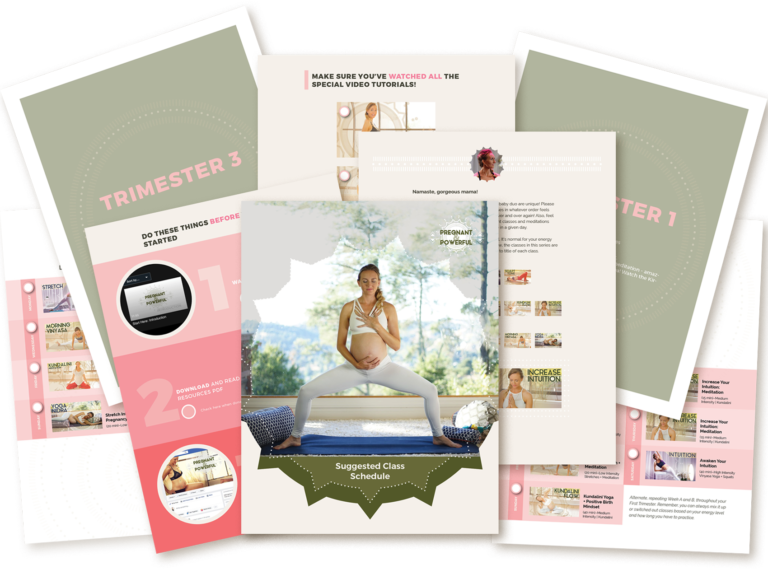
YOU MIGHT ALSO LIKE
- The Best Kundalini Yoga for Pregnancy: How to Practice Safely
- Yoga For Third Trimester: My Favorite Poses
- Home Birth vs Hospital Birth: Which is More Yogic?
- 9 Yoga Modifications for Pregnancy and How to Teach Them
- How To Relieve Pelvic Girdle Pain During Pregnancy
- What To Consider When Taking a YTT While Pregnant
- My Guided Pregnancy Meditation To De-Stress & Connect With Your Baby [VIDEO]
- 6 Natural Ways to Prepare Your Body For an Easy Labor & Delivery
- 6 Crazy Easy Pregnancy Meditation Tips For A Powerful Practice
- Six Essential Prenatal Yoga Poses for a Powerful Birth


